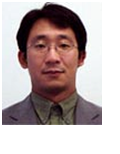|
Affiliation |
Graduate School of International Resource Sciences Department of Earth Resource Science |
NISHIKAWA Osamu
|
|
|
Graduating School 【 display / non-display 】
-
-1986.04
Tohoku University Faculty of Science Graduated
Graduate School 【 display / non-display 】
-
-1998.03
Tohoku University Graduate School, Division of Natural Science Doctor's Course Completed
Campus Career 【 display / non-display 】
-
2022.10-Now
Akita University Graduate School of International Resource Sciences Department of Earth Resource Science Associate Professor
-
2016.04-2022.09
Akita University Graduate School of International Resource Sciences Department of Earth Resource Science Lecturer
Research Achievements 【 display / non-display 】
-
Intra-granular strains and grain boundary morphologies of dynamically recrystallized quartz aggregates in a mylonite
Nishikawa, O., Saiki, K., Wenk, H.-R
Journal of Structural Geology 2003.01 [Refereed]
Research paper (journal) Domestic Co-author
-
Progressive lattice misorientation and microstructural development in quartz veins deformed under subgreenschist conditions
Nishikawa, O. and Takeshita, T
Journal of Structural Geology 2000.01 [Refereed]
Research paper (journal) Domestic Co-author
-
Dynamic analysis and two types of kink bands in quartz veins deformed under subgreenschist conditions. Tectonophysics
Nishikawa, O. and Takeshita, T
Tectonophysics 1999.01 [Refereed]
Research paper (journal) Domestic Co-author
-
Holocene diatom assemblages from bore-hole sediment in the Oga Peninsula, Akita, northeastern Japan
Shimada Chieko, Nishikawa Osamu, Saito-Kato Megumi
Diatom ( The Japanese Society of Diatomology ) 40 ( 0 ) 16 - 30 2024
-
Sedimentary facies and environmental evolution of the alluvium in the Iriai lowland, Oga Peninsula
Nishikawa Osamu, Shimada Chieko
The Quaternary Research (Daiyonki-Kenkyu) ( Japan Association for Quaternary Research ) 62 ( 3 ) 105 - 119 2023.08
<p>The burial of a sedimentary basin and Holocene environmental evolution were investigated based on facies analysis, radiocarbon dating, diatom and pollen analyses of six alluvial drilling cores drilled in the Iriai lowland, north coast of the Oga Peninsula, NE Japan. In the Iriai lowland, about 15 m-20 m of alluvium buries a broad valley topography that was formed by scouring the Pleistocene sediments during the last glacial stage. The basement of the basin consists of a sand layer of the upper Pleistocene Katanishi Formation and a mud layer of the lowermost horizon of the Hakoi Formation of approximately 40,000 years ago. The environment of the Iriai lowland changed from an alluvial fan at the last glacial maximum to a floodplain about 10,000 years ago and to a bay about 8,500 years ago due to the sea-level rise caused by postglacial warming. At the height of the Jomon transgression, the area was transformed into a lagoon or fresh water lake which was often influenced by seawater. Subsequently, the delta progradation and the shrinkage of water area gradually occurred from the south as regression, and about 3,000 years ago, the area became a lowland with a hinterland swamp environment.</p>
-
Mineral Industry Museum, Akita University —Highlights in Mineral Science—
NISHIKAWA Osamu
Japanese Magazine of Mineralogical and Petrological Sciences ( Japan Association of Mineralogical Sciences ) 52 ( 1 ) n/a 2023
<p>Mineral Industry Museum, Akita University —Highlights in Mineral Science—</p>
-
Anisotropy of elastic wave velocity of Neogene sedimentary rocks in the Akita area: Influences of compaction and regional stress field
NISHIKAWA Osamu, NIIDA Takumi, SAITO Haruto, IMAI Tadao
Annual Meeting of the Geological Society of Japan ( The Geological Society of Japan ) 2023 ( 0 ) 70 2023
-
Raman Spectroscopy of Natural Titanomagnetites
HULIJELI Leeysmon, WATANABE Yasushi, NISHIKAWA Osamu, Alen J. TUPAZ Carmela
International Journal of the Society of Materials Engineering for Resources ( 日本素材物性学会 ) 25 ( 2 ) 243 - 248 2022.10
<p>The Raman spectral patterns of analyzed natural titanomagnetite samples revealed peaks at 670-680 cm<sup>-1</sup>, 544-603 cm<sup>-1</sup>, 407-495 cm<sup>-1</sup> and 373-392 cm<sup>-1</sup> that correspond to the A<sub>1g</sub>, T<sub>2g</sub> (2), T<sub>2g</sub> (3) and E<sub>g</sub> vibrational modes of the spinel <i>Fd3m</i> space group. Previous studies of titanomagnetite Raman spectra patterns have suggested the behavior of these peaks reflect the distribution of Fe<sup>2+</sup>-O, Fe<sup>3+</sup>-O and Ti<sup>4+</sup>-O bonds within the titanomagnetite crystal structure. The peak intensities of each vibrational modes are observed to be relative, reflecting the re-distribution of Fe<sup>2+</sup> and Fe<sup>3+</sup> in both the tetrahedral and octahedral sites as a function of Ti concentration. Existing titanomagnetite Raman spectroscopy studies are limited to analysis of synthetic titanomagnetite. In this study, Raman spectral patterns from natural titanomagnetite i.e., magnetite-ulvöspinel solid solution samples were analyzed to determine behavior of Raman spectrum peak positions and intensities due to changing content of Ti<sup>4+</sup>, Fe<sup>2+</sup> and Fe<sup>3+</sup>.</p>

